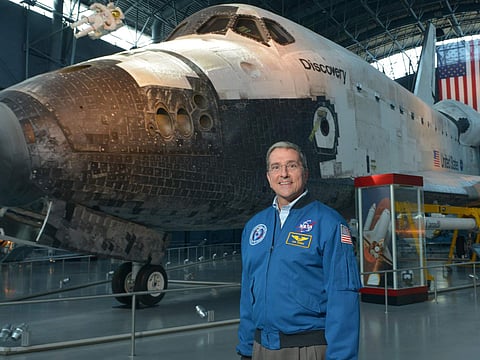
- LIFESTYLE
- FASHION
- FOOD
- ENTERTAINMENT
- EVENTS
- CULTURE
- VIDEOS
- WEB STORIES
- GALLERIES
- GADGETS
- CAR & BIKE
- SOCIETY
- TRAVEL
- NORTH EAST
- INDULGE CONNECT

The night was cold, and the sky was awash with stars. It’s 1969, and staring up at the Cleveland sky was 14-year-old Donald Alan Thomas, now a former NASA astronaut. He was looking up into the void to spot the moon on which America’s Apollo 11 just landed — the world’s first-ever human contact with the moon. He recalls, “I remember going outside at one in the morning. I looked up at the moon, and I just couldn’t believe that humans had landed on the moon. It really was a magical moment, and it brought the whole world together. Everybody watched, listened and celebrated this achievement as it truly was for all of mankind.”
That boy grew up to be an astronaut who ventured out into space four times. He states how role models from his home state of Ohio, namely John Glenn and Neil Armstrong, played a key role in fuelling his dream of going to space. Now that he’s retired, he works at Towson University and occasionally speaks to students of all ages around the world, in an attempt to motivate them. The former NASA veteran is coming to Chennai soon to present a keynote address, where he hopes to address youngsters in the country and maybe even inspire some of them to pursue a career in space — just as he decided to become an astronaut after watching a TV broadcast of America’s first manned orbit by John Glenn in 1962. “Later, when I was 14, Neil Armstrong landed on the moon and that just reinforced it for me,” recalls Don, as he prefers to be addressed.
Star struck
He speaks in excitement about his experiences in space (one of them included a Discovery mission too), as he describes spotting the Great Barrier Reef of Australia, 16 sunrises and sunsets, and shooting stars. But, it wasn’t all about stargazing. He talks about working extensively in laboratories situated within the spacecraft. In fact, on most missions, they worked for roughly two weeks straight, and did over 200 experiments each time, for researchers around the world. He explains the importance of completing such a vast number of tests. “We did experiments up in space for almost every field of science that we could think of — because of one major parameter — gravity. Gravity is zero in space, and we compared it to normal earthly gravity. Everything we did up there was fun.” Apart from laboratory experiments, they also studied the effect of gravity on astronauts. He says that these results may one day aid in “travelling to Mars in the future or for longer missions.”
Just like everything else in life, pursuing a career in space does come at a price. Don relives the sacrifices he had to make to achieve his dream of flying to space and running a family simultaneously, “I would be lying if I told you that NASA had no impact on our family life. I didn’t have any hobbies, nor did I take up activities like golf, for instance. My son was born between my first and second mission. The family has to be very supportive and understanding.”
Space jam
This difficulty did in no way deter Don, as he flew four missions amounting to a total of 44 days in space. Comparing it to a rollercoaster ride, he explains, “As soon as I landed from my first mission, in around two to three minutes, I immediately knew I had to do this again.” However, the 64-year-old then adds that, “I would say any astronaut who tells you they’re not afraid during launch, they’re either lying to you or they’re crazy. We had one space shuttle that blew up during launch, and one blew apart when it landed. So, it’s always a possibility. It probably won’t happen in your mission, but you never know. I think it’s healthy to be a little bit scared on launch day as it is the most dangerous part of the mission. You have nearly two million litres of explosive rocket fuel feeding our engines, a lot of shaking and vibration, a lot of moving parts. Once we got to space, I felt much safer.”
With India’s own lunar mission launch, Chandrayaan 2, right around the corner, he offers insight into India’s stride in space travel, “India has been doing extremely well launching and building satellites, so it all comes down to budget and priorities. It is tough to summon money from the government that has to go for education, health, housing, and cultural things. It’s a tough balance.”
Power up
While the life of an astronaut is glamorous, Don explains how fitness is important. “It is left up to the astronauts. They have to pass a physical every year and that’s a great motivator. The best exercise is one that you enjoy doing. The key to exercise is to do it regularly.”